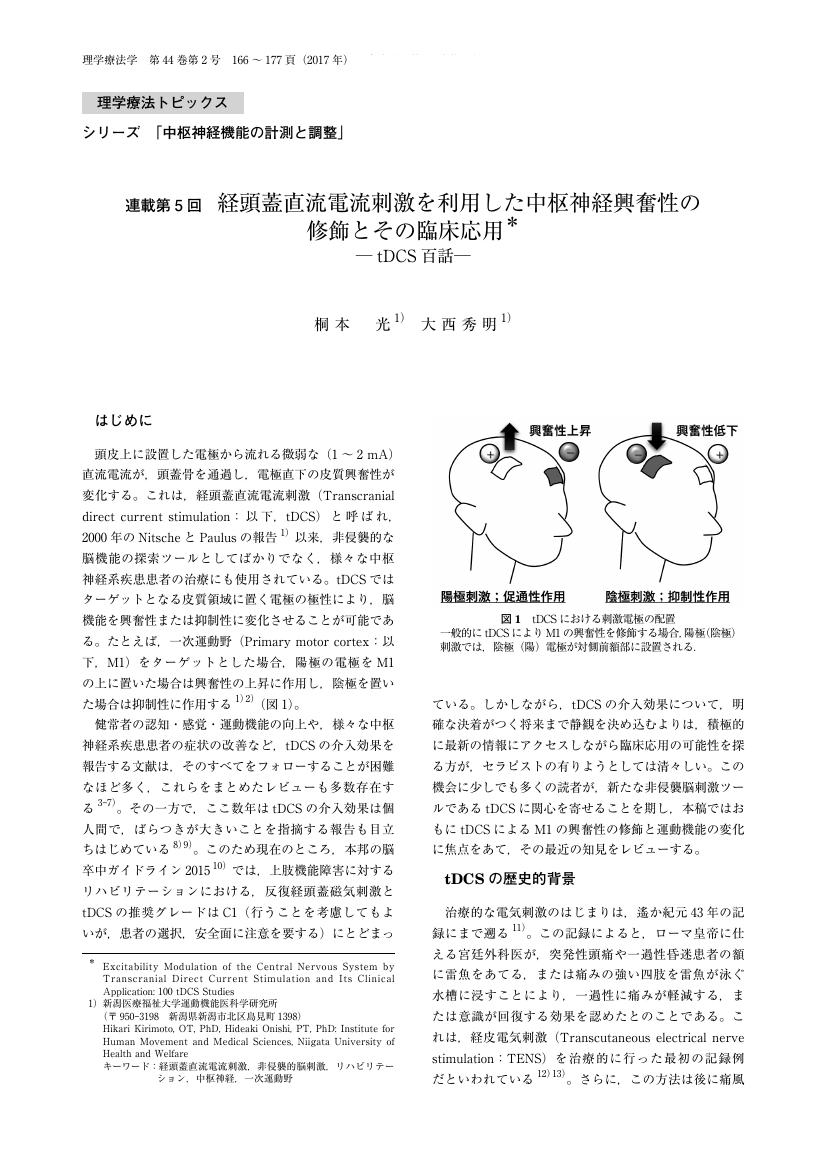4 0 0 0 OA 補足運動野に対する経頭蓋直流電流陰極刺激が先行随伴性姿勢調節に及ぼす影響
- 著者
- 吉田 翔太 桐本 光 松本 卓也 小島 翔 鈴木 誠 大西 秀明 田巻 弘之
- 出版者
- 一般社団法人 日本臨床神経生理学会
- 雑誌
- 臨床神経生理学 (ISSN:13457101)
- 巻号頁・発行日
- vol.41, no.4, pp.202-208, 2013-08-01 (Released:2013-11-01)
- 参考文献数
- 15
- 被引用文献数
- 2
主動作筋の活動に先行して姿勢調節筋群が放電開始する現象は, 先行随伴性姿勢調節 (APAs) と呼ばれ, 補足運動野 (SMA) がその生成に関与すると考えられている。本研究では, SMAに対する経頭蓋直流電流陰極刺激 (陰極tDCS) が, APAsの機能に影響を及ぼすか否かを検討した。健常被験者11名が, 自己ペースで右上肢を急速拳上する課題を重心動揺計上で行い, この時の右三角筋と右大腿二頭筋の活動を表面筋電図で記録した。左側M1 (Cz上) とSMAに陰極tDCS (2 mAで15分間) 及び疑似刺激を行い, 刺激前後における両筋の放電開始時間差 (ΔEMG onset) の変化を比較した。陰極tDCS後におけるΔEMG onsetの有意な短縮はSMA刺激時にのみ認められた。APAsの生成にはSMAが重要な役割を果たし, また陰極tDCSはSMAの予測的姿勢調節機能を抑制し得ることが示唆された。
4 0 0 0 OA 経頭蓋直流電流刺激を利用した中枢神経興奮性の修飾とその臨床応用
2 0 0 0 OA 竹刀を用いた光刺激に対する引き技動作の筋電図反応時間及び打撃動作時間の分析
1 0 0 0 OA 経頭蓋直流電流刺激の効果的な介入方法の検討 -電極貼付部位および電流強度の影響-
- 著者
- 宮口 翔太 大西 秀明 小島 翔 菅原 和広 桐本 光 田巻 弘之 山本 智章
- 出版者
- 一般社団法人日本理学療法学会連合
- 雑誌
- 理学療法学 (ISSN:02893770)
- 巻号頁・発行日
- vol.42, no.3, pp.213-219, 2015-06-20 (Released:2017-06-09)
【目的】本研究の目的は,電流強度および電極貼付部位の違いが経頭蓋直流電流刺激(transcranial direct current stimulation;以下,tDCS)の効果に与える影響を明らかにすることとした。【方法】対象は健常成人9名とした。tDCS介入条件は,陽極電極を左一次運動野領域に貼付し,陰極電極を対側前額部または対側一次運動野領域(bilateral tDCS)に貼付し,1.0mAまたは2.0mAにて10分間刺激する計4条件とした。各条件におけるtDCS介入前後に経頭蓋磁気刺激により左一次運動野領域を刺激し,運動誘発電位を記録した。【結果】bilateral_2.0mA条件においてのみtDCS介入前に比べ介入終了2分後,10分後の運動誘発電位が有意に増大した。【結論】bilateral tDCSにより2.0mAにて刺激することで,大脳皮質の興奮性が安定して増大することが明らかになった。
- 著者
- 與谷 謙吾 今泉 英徳 桐本 光 北田 耕司 田巻 弘之 荻田 太 竹倉 宏明
- 出版者
- 日本生理人類学会
- 雑誌
- 日本生理人類学会誌 (ISSN:13423215)
- 巻号頁・発行日
- vol.12, no.3, pp.139-146, 2007
- 参考文献数
- 30
- 被引用文献数
- 1
Visual stimulation-reaction time and subsequent strike time in the sport of kendo were assessed using electromyographic (EMG) reaction time. Fourteen male college students (kendo athletes (n=7), non-kendo athletes (n=7)) were asked to perform a kendo strikes in response to visual stimulation from a flashing light signal. The strikes employed, the Hiki-Men (HM) and Hiki-Kote (HK), were performed using a bamboo sword, or Shinai, using both of the upper limbs as quickly as possible. The EMG signals from the right (R) and left (L) biceps brachii, the R-, and L-triceps brachii, and R-flexor carpi ulnaris muscles were recorded simultaneously together with the elbow joint angle and hitting shock signals. Total task time (TTT), pre-motor time (PMT), motor time (MT), and action time (AT) were measured for the HM and HK tasks. The photo stimulation body reaction time (BRT) was also measured. Significant strong positive correlations were observed between PMT and TTT for both HM and HK tasks (p<0.01, r=0.93-0.94). Multiple regression analysis was used to determine the contribution of each component of the model in TTT. The standardized partial regression coefficient (β) was significant (P<0.01) for MT (β=0.36-0.38), AT (β=0.49-0.56) and was highest for PMT (β=0.79-0.80). The individual time ratio for PMT, MT and AT to TTT was approximately 50%, 20% and 30%, respectively. No significant correlations were observed between BRT and TTT for the HM and HK tasks (r=-0.02, 0.16). These results suggest that PMT is the most important component contributing to the TTT, and that BRT is not correlated to the TTT in kendo strikes.

